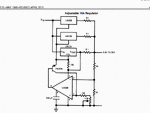3BABY
Member level 5
- Joined
- Jan 14, 2011
- Messages
- 91
- Helped
- 0
- Reputation
- 0
- Reaction score
- 0
- Trophy points
- 1,286
- Location
- New Zealand
- Activity points
- 2,252
Hi All,
i have the below circuit, straight out of he Texas LM338 datasheet as a reference circuit, i would like to use it to build a 15-20A 8v power supply, what i dont understand from the circuit is the resistors R5 and R6 being 0.1 Ohm each. i understand that for 15A the circuit uses all 3 LM338's specified at max 5A output, but what i dont understand is why the resistors are there (R5, R6) ? more i dont understand what rating they will have to be. the biggest i can find is around 3W.. if my basic calculations are correct 5A*8V = 40W.. isnt this going to blow R5, R6 straight out of the circuit?? your help please for my understanding would muchly appreciated
also note: i have found replacement for the LM307 as Analog Devices OP177.. as LM307 is not longer available.
Thanks!

i have the below circuit, straight out of he Texas LM338 datasheet as a reference circuit, i would like to use it to build a 15-20A 8v power supply, what i dont understand from the circuit is the resistors R5 and R6 being 0.1 Ohm each. i understand that for 15A the circuit uses all 3 LM338's specified at max 5A output, but what i dont understand is why the resistors are there (R5, R6) ? more i dont understand what rating they will have to be. the biggest i can find is around 3W.. if my basic calculations are correct 5A*8V = 40W.. isnt this going to blow R5, R6 straight out of the circuit?? your help please for my understanding would muchly appreciated
also note: i have found replacement for the LM307 as Analog Devices OP177.. as LM307 is not longer available.
Thanks!

Last edited by a moderator:
